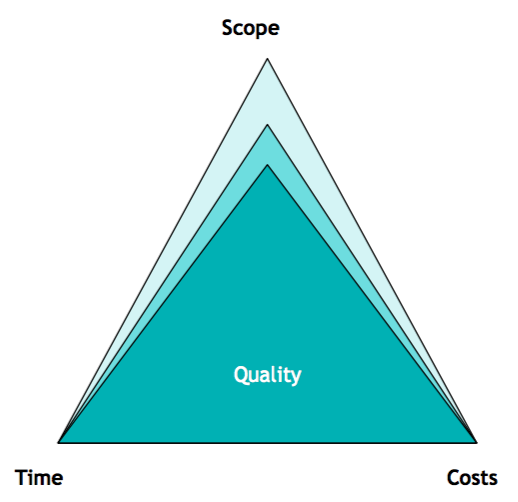Table of Contents
Once you have released the software solution, its development process will never end. Due to expanding the range of technologies, software product needs constant maintenance and upgrades. You can not predict how much you are going to spend to maintain the solution, but what you definitely can plan and manage is your project’s budget. Budget planning helps to reveal main business goals that should be reached with the solution, define product requirements and estimate their combination.
To get a successful final product, do not try to economize from the very beginning. It doesn’t mean that you will have to invest everything you have but we recommend considering the team`s advice as your project`s functionality can be expanded according to business and industry needs.
Why you need a project budget plan?
The specification stage is essential for scoping and budgeting the project. Imagine the situation when you assign the solution development to the hired team but do not identify the project`s priorities and key requirements. Clear that it is impossible to scope and estimate the entire project. A brilliant solution idea is great but it should be detailed discussed and described to build and release a successful product.
A well-planned project budget gives full control of the development process and its progress. It also shows the availability of funds and its correspondence to the developed parts of the product.
Creating a basic project budget
Having chosen the software development company, you go through the pre-development stage that is usually called the discovery phase. This step is a must for each software project as it helps to define all needed information about the client’s needs, business goals, project aims, and specifications. Forming the budget is possible only after defining all product requirements and the range of functionality that is needed to perform those requirements.
The discovery stage is obvious in cases:
- when a client has not identified the project priorities yet;
- when a client clearly understands what functions the product will include.
The discovery phase of the solution development consists of several main steps that aim to form the budget in the end.
Approaches estimating projects
Talking about the estimation stage, there are several well-known approaches to budgeting that are usually intertwined and substitute each other during different phases of development.
Analogous approach
The analogous estimation model is considered to be actively used among software development companies. It implies a comparison of the required functionality with similar developed projects and an evaluation of the future project based on those estimations. Essentially to understand that each software solution is supposed to be unique. Despite the basic functionality, it will have diverse business goals, features, and design, for example. Starting the development process, you can not be 100% sure that your project will end exactly like similar projects.
Due to the vast experience of estimators, the numbers and required time can be variable to release the product successfully. Moreover, far not all estimations were done highly qualified and accurately. Meaning it is senseless to rely on a similar project estimation, especially when the specialist hasn’t been working on that project and do not know the peculiarities of its development. On the contrary, if the estimator perfectly knows that your project is just the same, then this budgeting approach is the best variant for your project as it takes less time, costs, and effort.
Parametric approach
The parametric estimate approach is the suitable variant when the project requirements are revealed. Counting the main functionality of the future product lets specialists quickly estimate the project. The estimator knows what professionalists you need and how much time they usually spend to perform the highlighted parameters. This estimation is a kind of approximate as it is only the prediction.
In fact, the time spent on building your solution can be expanded as well as shortened. At the previous approach, the estimator means the price of similar projects. This approach implied considering the particular project`s parameters and the separate price for each of them. Further, some of the parameters can reveal unnecessary and some others can be added. Monitoring the development process and comparing it to a set budget is essential to be aware of the possible final estimation.
Bottom-up approach
The bottom-up estimation technique is supposed to be the most accurate estimation approach as it considers each detail, therefore, takes more time than usual. This estimation type can be called the most useful as it contains the detailed description of the projects meaning big parts are divided into smaller groups of goals and tasks. These smaller parts are identified to define what requirements and effort are needed to perform them.
This approach also implies discussing the materials and planning the deadlines for each component of the project consequently defining the needed budget. These small groups determine the final price of the project and help to create an accurate project budget – from the bottom to the top. Dividing the entire projects into separate elements is supposed to be a perfect way to perform estimation within the budget as the client can decide whether any component is required at the early stage of development and change them without harm.
Top-down approach
The top-down estimation approach is the opposite of the bottom-up estimation type. It has little to do with accuracy and details. This estimation is initially based on general requirements or functionality. Estimators usually use similar project documents or evaluate them superficially. Mostly this approach is changed during the development process.
The top-down estimation aim is to show the preliminary project estimation and the needed budget to know if the client is ready to start the development and if the average price is appropriate. This type is used at the stage of researching in the industry and defining the project specifications to make the client engaged. Average estimations are going to change as they can be expanded due to the project`s requirements as well as reduced. The top-down approach is not based on any analysis, it is used just for approximate knowledge.
Three-point approach
The three-point estimate approach considers all positive and risky sides when planning the project budget. It initially helps to count the lowest (MVP) and the highest case of the future project. Comparing these estimations, clients get a perfect variant to allocate the budget. Mainly, there are two formulas of estimation:
Triangular distribution
E = (a + m + b) / 3
- E = estimated cost
- a = optimistic value
- m = most likely value
- b = pessimistic value
Beta distribution
E = (a + 4m + b) / 6
- E = estimated cost
- a = optimistic value
- m = most likely value
- b = pessimistic value
Most software projects combine several budgeting approaches. During the pre-development stage, we define the client’s business assets and project aims that let us make assumptions about its functionality and required technologies. Then, we check the analogous or basic projects with similar functions that means following the analogous approach. Anyway, research is a must no matter if we have similar projects or not. Since then we are ready to estimate the product.
Altamira Project manager
Pricing models for budgeting software project
Along with approaches to budgeting, there are also different pricing models that help to keep track of the budget. We would like to highlight two main pricing models that are widely used among our clients. Both of them have positive and negative sides, so it is always up to the client’s decision.
Best practices to keep a project under budget
We were researching the best practices of tracking the budget from the experienced project managers. Below we highlighted the most interesting and important techniques that will help you to keep track of the project budget and rationally allocate it to build the software solution.
Do not diminish the need for risk prediction and its impact
Planning and allocating the budget is an important task in developing software solutions. However, there is one more not less important thing in budgeting – risk prediction. This part demands thorough attention as any risk can have a huge impact on the entire development process and therefore the budget. First of all, think of any risk that could ever happen for this particular project, then research their effect on the budget and what this can turn into financially.
Ensure that requirements are strong
During the specification stage, all essential requirements should be double discussed, agreed upon with a client, and signed in the documents. This is a useful feature for both sides – for clients as well as for the development company. As we have already mentioned, the final sum of the project can be variable due to the spent time, ranks of specialists, and functionality of the project. Sometimes certain parts of the project can take more time than was expected, and it is important to discuss and include such cases in documents. It allows the development team to go beyond the budget to perform the required functionality.
Divide the entire project into smaller groups of tasks
The discovery stage includes a particular range of tasks that should be performed before the start of the development process. After defining the business assets and researching the industry, the next stage is specifications. Usually, these docs contain main project requirements that consequently are divided into smaller parts like user stories and epics. Each product function has to be narrowly discussed and written down. If it is a social media app, the entire project is divided into features like news feed, user profile, online payment, etc. Therefore, each of the counted features is illuminated with the step-by-step list of actions that users will have to perform. These details show the final project visualization and help to build a highly qualified product.
The project has to correspond to client expectation
Ensuring that your client clearly understands and tracks each development stage is crucial. Provide constant communication and make sure that the client gets everything that is going, sees where his money goes, monitors how much time was spent on a particular part of the project, etc. It helps to avoid misunderstandings and difficulties with the budget. The client has to get what he expects, so any changes or updates have to be discussed and resolved with the client not to go beyond the budget. Only clear goals and project requirements make the process run smoothly and transparently for both sides – the company and the client.
Make sure all planned resources are available
You need to understand that software development companies have specialists with diverse levels of skills and experience. Developers’ experience, replacement day-offs, other project occupancy influence the budget a lot. For example, you start the development process with a formed team of professionals. However, there are cases when some of them can be absent, relocated to other projects, or even fired. Therefore, you will need to change the team and add other developers to your team. It can have two sides – the developer of higher rank that demands fewer hours but more budget, and the developer who has less experience and needs more time to finish the project. Both cases involve a bigger budget due to more experienced specialists or more time spent on the development for the entire team.
Double-check everything counted above
Double-check and budget control are your best friends during the development process. Do not be afraid to waste a little more time discussing the project specifications to avoid unpleasant situations. Due to clients likely to leave feedback at the end of the cooperation, you have to be interested in positive comments and successful project release you value your reputation.
Popular project estimators tools
Microsoft Excel
Microsoft Excel is a universal budget creator as it provides spreadsheets with different formulas that help to automate some calculations and can be easily updated. It is a good choice for any type of budgeting – from daily personal budget to software project development.
Google Sheets
Google Sheets looks similar to Microsoft Excel. It is a perfect match for Google users as all Google services are connected and easily accessed from one account. Google Sheets is a blank slate where users can create their own categories, add formulas for automatic calculation, share the documents with other users that also have access to edit, etc. We usually use Google Sheets for creating estimation docs as it is convenient, accessible, and clear. Here is a sample of our estimation document for your attention.
Price&Cost
Price&Cost is supposed to create accurate budgets as most features are automatic, so you don’t have to add numbers and formulas manually. Users choose particular options and get the calculations. There is also the option of exporting other files and their data like Microsoft Excel tables. This tool provides reports and forecasts, therefore, it is not free and has a monthly or yearly subscription.
BrainLeaf
BrainLeaf is one more paid budgeting service but the price justified. This tool offers a wide range of functions like creating user teams, budget templates, managing other users’ actions, filtered search for documents, and automatic calculations.
Checklist of things to create a project budget
Any software project development involves spending costs and all of them should be accurately planned and managed. We would like to recommend you to have a look at the list of leading questions that would help to reveal the main project’s requirements and fit them into the budget:
- What are the main business objectives of the project?
- What rules/laws/policies should be taken into account when developing?
- What pricing model would suit the best?
- What specialists do I need and who works in my team?
- What resources are required to end the project successfully?
- Should I compare my estimation and standard solution in this industry?
- Who helps me to manage the development within my budget?
FAQ
To end up
The success of a future software project depends on its accurate scope and budget planning. The project budget includes long lists of essential features that define the further development process like product functions, required technologies and developers, approximate hours, and estimation. These options are mostly variable and demand constant monitoring and updating. With close-knit cooperation between the client and the team of specialists, the successful project release is guaranteed even within the initial budget.




